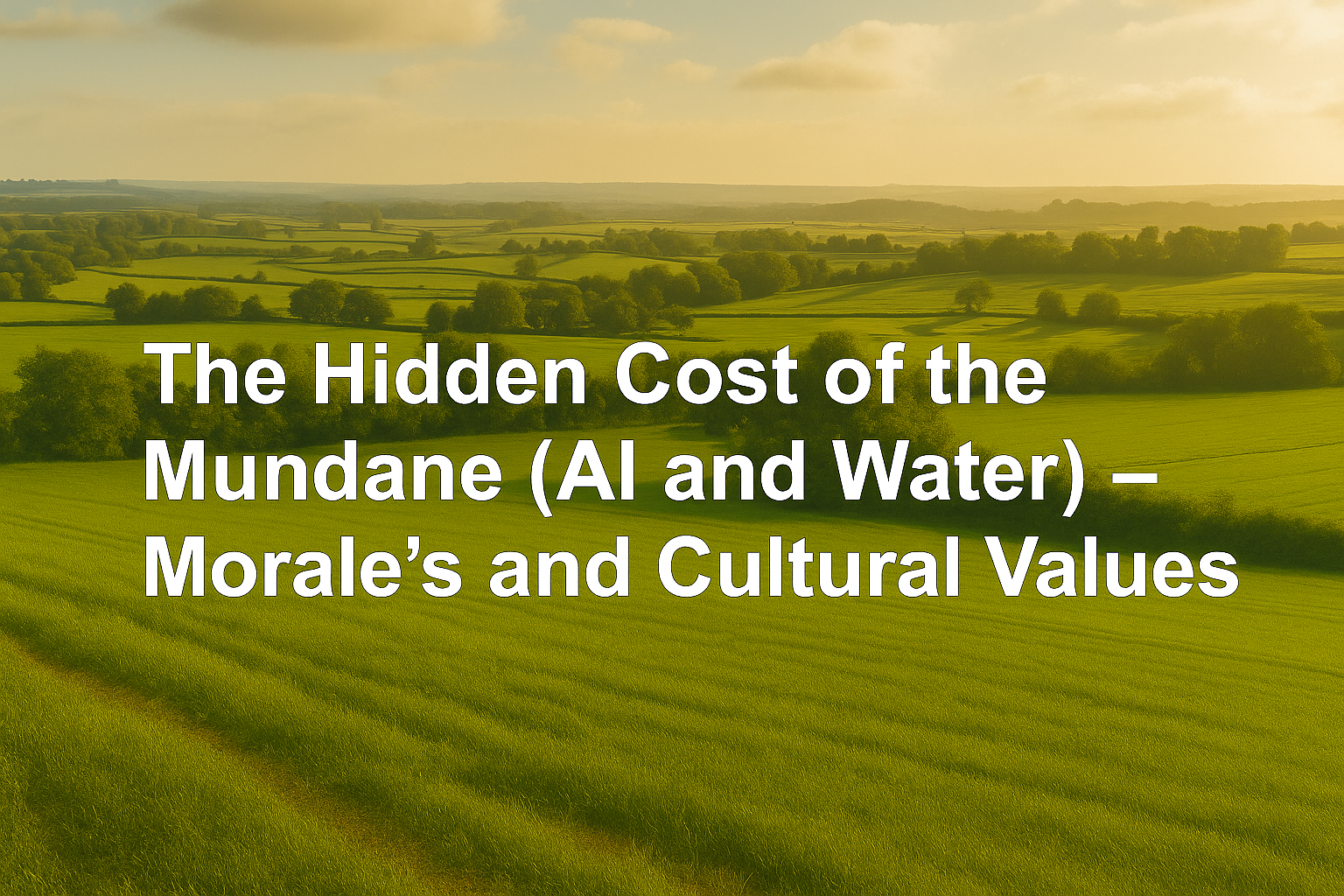
The Hidden Cost of the Mundane (AI and Water) - With Morale's and Cultural values added)
The Water Paradox: Why We Scapegoat AI Instead of Fixing a Thirstier Problem
It is a startling statistic that a single pair of jeans can have a water footprint equivalent to thousands of AI conversations. But this begs a more important question for 2025: Why is our intuition so wrong about this? Why is it so easy to picture a data centre as a thirsty villain and so hard to see the desert hidden in our wardrobe?
The answer is a glitch in our thinking. Our brains are hardwired to magnify new, concentrated threats while downplaying familiar, distributed ones. This is not just a psychological quirk; it is actively steering policy in the wrong direction. As one source explains, "Salience bias refers to our tendency to focus on items or information that are more prominent or emotionally striking and ignore those that are unremarkable, even if this difference is irrelevant." This bias is causing us to debate the cost of the shovel while ignoring the mountain we need to move.
From Cost to Investment
The debate so far has been about comparing costs. Let us upgrade the conversation. Instead of asking 'How much water does AI use?', we need to ask, 'What is AI's Return on Water Invested?'
The numbers are stark. Consider this: "The life cycle of a single pair of Levi’s 501 jeans consumes 3,781 liters of water, from cotton production to consumer care." The vast majority of this is used growing cotton in colossal, inefficient systems.
In contrast, an entire conversation with an AI might use half a litre of water. The question is not whether those few drops are 'worth it.' The question is: how many thousands of litres can those few drops save us?
AI as a Water-Saving Engine
We can deploy AI to fix that 3,781-litre problem at its source. The biggest culprit is inefficient irrigation for cotton. AI-powered systems using drones and soil sensors can deliver water with surgical precision.
This is not a theoretical benefit. Research shows that "AI-supported autonomous irrigation systems led to 30–40% greater water efficiency compared to manual irrigation systems." We are using a few millilitres of water in a data centre to save almost 2,000 litres in a field. Beyond the farm, AI optimises logistics to reduce the 'embedded water' in millions of unsold garments.
A Call for a New Perspective
Worrying about AI's water usage is an intellectual luxury we cannot afford. It is a failure of imagination. The real environmental catastrophe is not the cost of running our new intelligence engine; it is the cost of not aiming it at our oldest and most wasteful problems.
Our job as leaders is to focus the conversation on leverage. We must frame AI not as a utility cost to be minimised, but as our most powerful tool for radical resource efficiency and sustainable growth.
Here is what we can do:
- Shift the Policy Debate: Stop blocking data centres on the basis of water usage. Instead, incentivise them to partner with local agricultural and industrial sectors to achieve regional water neutrality.
- Mandate AI-Powered Audits: Challenge our most water-intensive sectors like agriculture and textiles to use AI to audit their supply chains and report on their "Return on Water Invested."
- Lead the Narrative: Frame AI as our primary tool for sustainable growth. In the UK, data centres are already an economic engine with a contribution to our economy similar in size to the entire agriculture sector. We need them to power the solutions to our biggest challenges.
Links:
- Levi Strauss & Co. (https://www.levistrauss.com/sustainability-report/climate/water-stewardship/), Trust rating: High, Reason: Official corporate sustainability data providing the core statistic on jeans' water footprint., date written: 2023
- The Decision Lab (https://thedecisionlab.com/biases/salience-bias), Trust rating: High, Reason: Respected behavioural science publication providing a clear definition of the core psychological concept., date written: Accessed 2024
- National Center for Biotechnology Information (NCBI) (https://pmc.ncbi.nlm.nih.gov/articles/PMC11902001/), Trust rating: High, Reason: A peer-reviewed scientific paper offering credible evidence of AI's water-saving capabilities in agriculture., date written: May 22, 2024
- Public First (https://www.publicfirst.co.uk/data-centre-access-and-local-economic-growth.html), Trust rating: High, Reason: Research report quantifying the significant economic impact of data centres in the UK, supporting the productivity argument., date written: July 2023
Quotes:
- Levi Strauss & Co. (https://www.levistrauss.com/wp-content/uploads/2015/03/Full-LCA-Results-Deck-FINAL.pdf), Trust rating: High, Reason: This quote provides the core, staggering data point that anchors the entire argument. It establishes the massive water footprint of a common product., date written: 2015
- The Decision Lab (https://thedecisionlab.com/biases/salience-bias), Trust rating: High, Reason: This quote provides the psychological theory that explains why the public debate is misdirected, giving a name to the cognitive glitch., date written: Accessed 2024
- National Center for Biotechnology Information (NCBI) (https://pmc.ncbi.nlm.nih.gov/articles/PMC11902001/), Trust rating: High, Reason: This quote is hard evidence for the 'Return on Water Invested' concept, showing AI dramatically improves efficiency and output., date written: May 22, 2024

